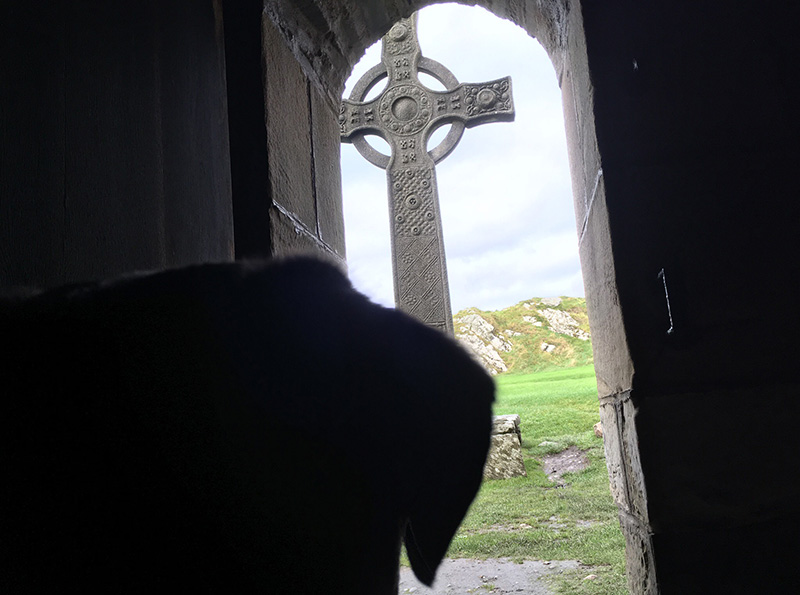Iona is one of those in-between, ‘thin’, places
I am very new to this game: this is the first blogpost I have ever written. I don’t even do Facebook. So how do I begin?
Well, let me share with you some thoughts about a recent trip. They may form part, eventually, of the book I am struggling to write at the moment – never let anyone tell you that writing is an easy job, for it ain’t. We went to Iona: both of us had been before, and had found it a strangely quieting yet at the same time disturbing place – disturbing of the usual assumptions and imperatives with which one lives.
Iona is of those in-between, ‘thin’, places – indeed, it was of this very place that George MacLeod first used that expression. Between the tumultuous highway of the Atlantic and the wild solidity of Mull, between then and now (for ‘then’ is never far away), between knowing and unknowing… The Abbey church is far unlike the Celtic church that once was here: the community was refounded as Benedictine by Ranald, son of Somerled, Lord of the Isles, in the 1200s, and its worked stones and arches speak of France, of Rome, and remind of the argument lost at Whitby. His sister Beathag founded the Augustinian nunnery down the lane, and was its first prioress. (I have been to the island in the loch on Islay brother and sister called home once.)
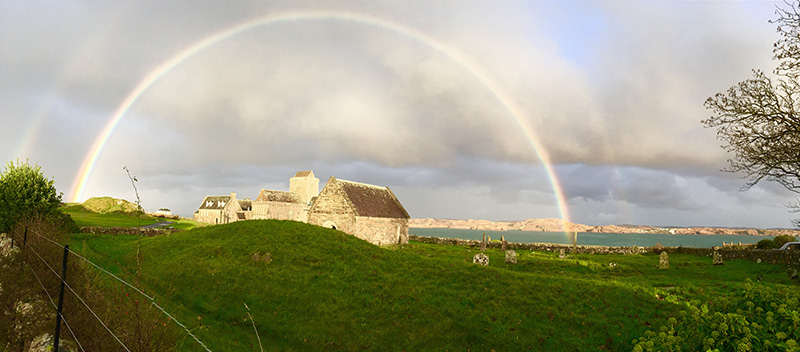
The men running the little Calmac ferry from Fionnphort to the island must have one of the most boring jobs in one of the most beautiful places in west Scotland – though the fast currents and rips in the sound can be tricky. Ten minutes to the holy place, with a whiff of diesel and hot engine. And back again. And so on. But then, Charon must also have got fed up with all those short journeys across the Styx, and been irritated by all those passengers, shades, waiting for the next ferry to another world, stretching out their hands imploringly in their desire for the other shore. ‘Wait for the next boat!’ he grumpily calls, as he fends them off with his oar. Ten minutes back and forth, all day, across the little sound, where in the shallows of the clear water sea anemones wave their florid tentacles for passing food and urchins make their slow progress across the rocks. A canny otter is regularly seen waiting near where the fishermen sometimes gut their fish. Gulls glide by on stiff wings, watchful, and in season delicate terns shriek their harsh Norse name ‘kria’, flutter, and dive for little fish. The air smells salt. To port we can see the sunlight on the bay where in 806 a Viking raiding party massacred 68 of the monks. This bright place too has seen the darkness. This has been one of the fulchra of the world. It does not forget it. Maybe it still is. Will be.
We walked in silence from the ferry. So much slipped into temporary irrelevance as we had moved north from normality: first the immediate pressures of work, of managing the day to day, then the traffic and people thinned out, then came the big punctuation mark of the ferry across the sound from Mull. We had left the car on the other shore. Just two of us, and the dog, on that road many had trodden before us. The modern road only occasionally overlaps the old pilgrim route from Martyrs’ Bay. The Celtic monastery, long gone, is now only imaginable in the deductions of the spade. But even so the place imposes a silence on the mind. ‘Listen. Be still.’ Perhaps it is because we expect it to, from what we have read. Perhaps there is another reason. We picked out – we had done our homework, of course – several of the features of the later Benedictine community’s buildings – they do run roughly to a pattern, as Roman forts do. But the twelfth century monastery was there for exactly the reason we were walking that road: because Columba, centuries earlier, and what he did, had made this a special place.
Columba was a well connected man who knew how to persuade and influence people – many of them his relatives. For he belonged to the ruling O’Neill dynasty of Ulster, and was an equal to the royalty of the people among whom he settled – deliberately he chose a place whence, according to his vow, he could not see his homeland. Like many great saints, he was far from other-worldly: he was a canny diplomat, an important person, a tough operator, who could request from his kinsman Conall mac Comgaill, king of Dál Riata, as from an equal, the site for a monastery, and get it.
Iona may have been a pre-Christian sacred site: was that why Columba chose it? The questions come thick and fast, and so far answers do not.
He built his cell, small and modest, so his biographer Adamnan (and a successor as Abbot) says, with his own hands. It is pretty certain that recent excavations (2017) have identified his writing hut on Tòrr an Aba, whence he could see the whole of the monastery and the sea beyond. Adamnan’s Life (697), describes Columba sitting in the hut ‘built on the higher ground… made of planks’, overlooking the sound, transcribing the Psalter. (After all, transcribing books was part of what all monks did: the Book of Kells was probably made here, though it is almost certainly a couple of centuries later than Columba.) He hears a shout from across the Sound of Iona, and when his unwelcome guest finally arrives (not from Porlock), in his eager haste to kiss the saint he upsets an inkhorn – a grave enough matter when you made your own ink.
Fallen field walls mark where farmsteads once had their in-bye land. Over on the west the ridges of old lazy beds remind of the long labour of men ploughing, and of women with creels on their backs carrying up kelp from the wrack on the shore to manure the land. We sat with our backs to the scarp of blown sand at the edge of the machair. The dog busied himself with doggy things on the tidemark. Far away by the dark cliffs we could see the columns of white spray shooting up from the blowhole of the Spouting Cave as the long Atlantic swells came rolling in. Sometimes the mist of spray hung in the air, caught in the updraught against the cliffs. This was one of the days of silence – or at least, no talking – we had promised ourselves. The noise of water on the beach, wind in the grass, a sheep faraway. On a rock, just offshore, capped with pinks and silverweed, cormorants dried their wings, and a dyspeptic looking heron (probably moulting) stood hunched up and glum. Rosanna likes herons: they remind her of her adored Russian grandmother, whose nickname, as she was long-legged, was Tsaplik – Russian for heron. A few oystercatchers flew up from the edge of the tide, piping their spine-tingling call. As if in answer from the moor behind the machair came the curlew’s bubbling call.
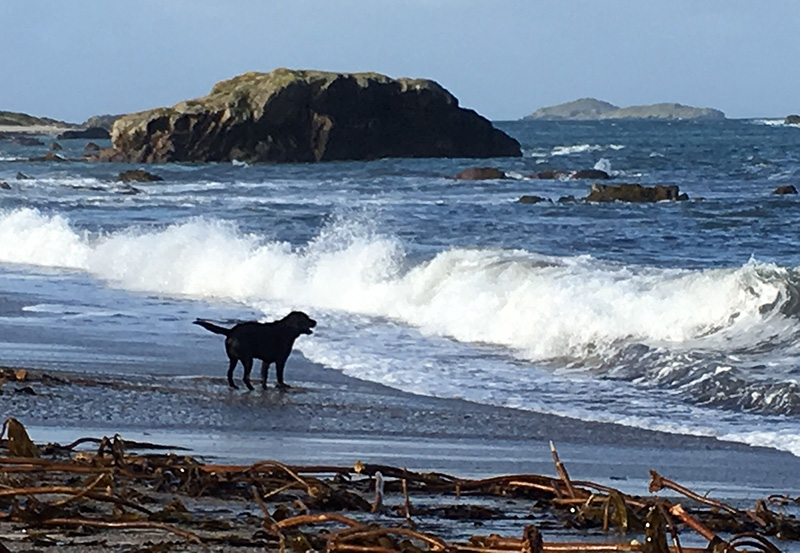
As you look over the quiet land with the wind off the sea in your hair, or as you might doze on a late summer afternoon on that western machair, rich in flowers, it is hard to recognise that it is in this quiet place that so many of the things first happened that we so easily assume were always there. Many aspects of Christian practice were still being formed when Columba built his cell. Here, for example, Christian graves are first marked with a cross. The long list of firsts includes the sacral ordination of kings (at Columba’s hand), the writing of an annual chronicle, and of the oldest Irish book, the Cathach psalter (possibly written by Columba himself), the production of sacred texts and books – in the 600s there are more from Iona than any other house in Europe. And, also, it was in Iona first that laws were framed to protect non-combatants in war. Now, in an age less civilised, our rulers and governors (I refuse to call them ‘leaders’) happily accept – but of course with much expressed regret – ‘collateral damage.’ Violence breeds violence: nothing is settled. Gustav Holst knew that so well in his Mars (1914). (I remember my infant granddaughter, literally infant, hardly able to talk, hearing that piece for first time, and crying with terror.) Had Holst an intuition, in what surely is one of the most frightening pieces of music ever written, that the coming War to End all War would be a Moloch that would demand the sacrifice of countless youth, that it would lead merely to the Long Weekend before the horror resumed in 1939? There are dozens of names of youths in their teens and twenties from this little place on the monument by Martyrs’ Bay, yards from where the monks were slaughtered.
It is a strange experience to walk the old pilgrimage route from Martyrs’ Bay winding up to the monastery enclosure and the group of three High Crosses standing before Columba’s church. It is now largely tarmac before you lift the latch of the gate, enter and tread the ancient stones. The first time I did it I constantly had the feeling that there were people just out of my borders of vision behind, just about to overtake. But the street was empty.
I set off alone to walk up Dun I – a wee hill, but the highest there is on the island, and for one who loves heights better than nothing. Near its southern foot is a collapsed drystone beehive cell, a hermitage in the wilderness. Not many people had trodden that way recently to judge by the path. I was not quite alone: a raven shadowed me, riding high on the wind and saying whatever ravens do say. A female hen harrier quartered the steep hillside with unremitting purpose. Just as it reached the shoulder of the skyline and passed from view, I saw it change attitude, and clearly stoop. A rabbit, perhaps: the place is full of them. Honour in some measure satisfied by having had a 360 degree view of the islands to the east and north and south and the restless Atlantic, I went over to the little water filled hollow, Tobar nah Aois,the Well of Youth – though some called it the Well of Healing or Well of Age. I prefer the first name: and have drunk a little of it. (I might be much worse not having done so.) I came down and rejoined the road. Near there my friend Matthew and his Mongolian wife and family camp every year, and take some of their water from the well, after a bracing early morning walk up the hill. Water and wells deserve honour.
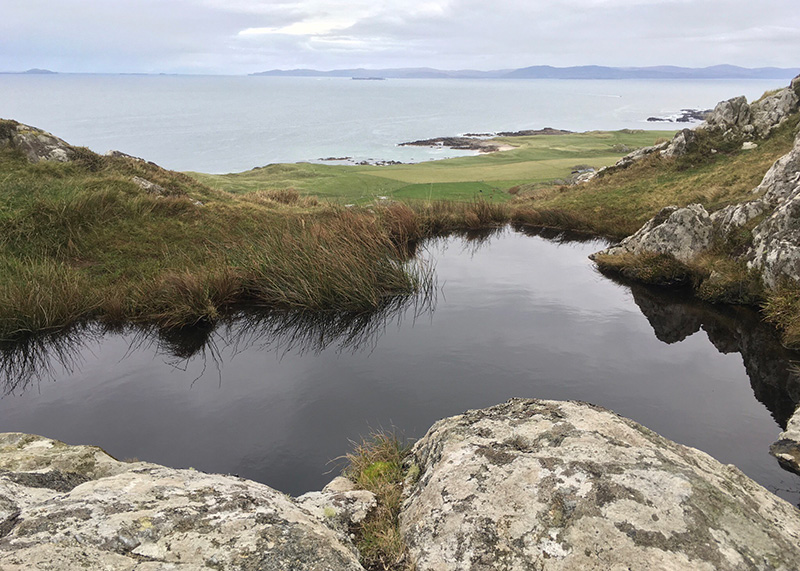
In a field, below a little rocky bluff that sheltered them from the windy rain that had just started, a little group of Highland cows was grazing. A small bull calf was paddling in the little burn. With that slow turn that their spread of horns makes advisable, its dam turned her head and lowed at it, as if to say, ‘you just come here and be a good boy and stop getting your hooves wet.’ A young bull came to my call at the fence, and loved having its ears rubbed, as Hector does, and when I stopped, nuzzled me to have it done again.
We got into desultory but friendly conversation with a man from Tennessee’s Smoky Mountains, who had been to Iona several times before on his secret search, and had now brought his Brazilian wife to share his memory. He complained that the slope of Dun Í had got steeper with twenty years of rest from his feet. He farmed fainting goats – goats bred for meat and as pets – on a considerable scale, he said. I looked blank, as well most people would. ‘Y’all en’t heard of faintin’ goats?’ And he brought out a phone and showed a You Tube video of these strange animals, who have a congenital disorder that makes them stiffen and fall over when frightened. When he continued by saying, ‘I sure have got coyote problems on my ranch’, to my shame, I could scarce forbear to say that as survival techniques go fainting left something to be desired, and coyotes would find them – well, easy meat. As a business model (I did not say) it might seem questionable. But then he completed the merry menagerie by telling us he had Pyrenean Mountain dogs to guard against the coyotes. It still all seemed rather exotic. But I now find that there is quite a market in these odd animals. I am not attracted.
Behind the Abbey church stands St Michael’s chapel. The predicted steep depression had arrived, and we were pretty soaked. I went through the door of the humble little building under the chevrons of the round Norman archivolts over the massy doorway. The door clunked as I shut it, and stilled the storm. The old walls have been re-roofed, and down the space of the single-celled building runs a long table surrounded by chairs. The pale light from the simple east window picks up the grain of the polished wood. Long stalls line the walls. I sat in silence, Hector quiet at my feet, quietly licking his wet fur. There was everything and nothing to say, and nobody and everybody to say it to. The storm outside beat on the roofs and walls, dimly heard. The wind threw handfuls of rain against the window. A wild night it would be. I thought of the Irish monk in the ninth century writing a poem in the margin of the MS (now in St Gallen) he was copying, grateful for the storm: ‘Hard is this wind this night. It combs the sea as an old man’s hair, white. This night the fierce raiders of Lochlann do not worry me, as their ships range over the wide sea.’ Yes, such a wind would certainly cool a Viking’s ardour. The boats would be flexing in the swell, their seams working, and they would run under bare poles. No thought of raiding. Not now.
Out into that pouring rain. Rosanna Petra joined me from the cloister and we butted our way back through the wind to the village. We met a very large American lady in a soaked Royal Stewart plaid that flapped drips from its hem in the half-gale’s gusts. She was on a day trip from Oban, and proudly said, with joy in her face, that she had come across the world to visit the land of her forefathers, that she had bought a cromach, and was wondering how she would get it on the plane to take home. She said she was in the direct line from Somerled, Lord of the Isles. A happy woman. Bless her.
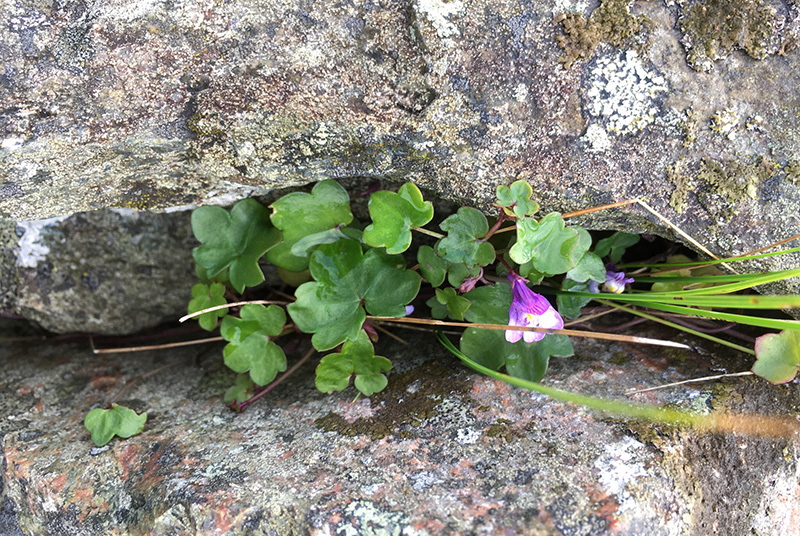
When the rain cleared, and the clouds that had loured upon us were buried in the deep bosom of the ocean, we walked north in the now brilliant light into a laundered world. Bright globes of rainwater sparkled on the leaves of alchemilla. On the harled drystone walls the ivy leaved toadflax glistened and the little purple flowers nodded at the sun when brushed by the wind. We made our silent way over the thin turf of the machair, and over the storm beach, and down to the sand where since the last tide someone had set out a little Celtic cross in white pebbles. A late butterfly dodged past – we were just another of those big things without nectar, so ignorable – low to the ground, and settled on a bit of ragwort at the edge of the rough grass. We sat in silence on the rocks, out of the strengthening south wind, by a little beach at the very north end of the island. Hector basked on the sand at our feet, occasionally waking up to do his doggy ablutions, while the eastern tide and the western flowed north past the island and joined their streams in a dance of foam and crisscrossing waves.
The autumn sun was at its zenith. The currents from the western and eastern sides of the island here come together – rather as our two lives have done – and their waves clash, and mount up in dancing curves as they meet, and in this bright light you can see right through their pellucid green. A minor glory, and the sun makes momentary rainbows in the little spray. Beyond lie the islands, and beyond them the uttermost parts of the earth.
By the shrine of Columba, we turned to enter the church. Rosanna bent her head as we went through the Norman door into the darker light inside. I stood just inside, with Hector, looking down the nave, which, unusually, slopes down rather than rises to the altar. Far down behind the altar the light of a new day shone through the window, silhouetting Rosanna as she turned right to enter the quiet space of the south chapel, where people leave prayer requests, and little beach stones in patterns before the icons, and a little wooden cross is silhouetted against the small light from the window. Hector, looking after her, whined gently, ears cocked.
